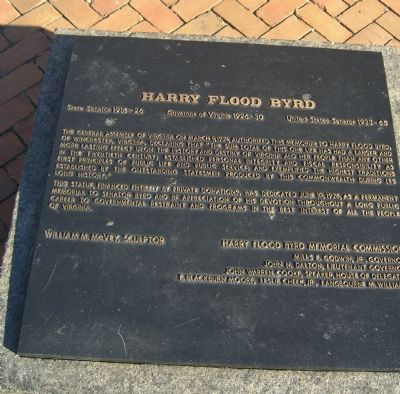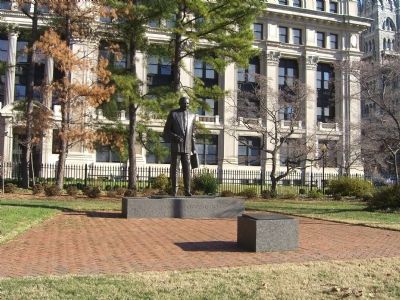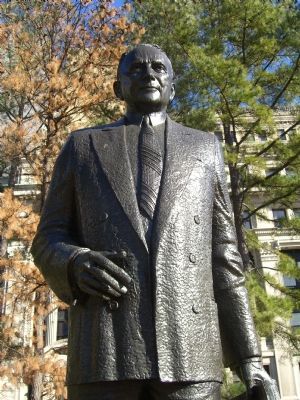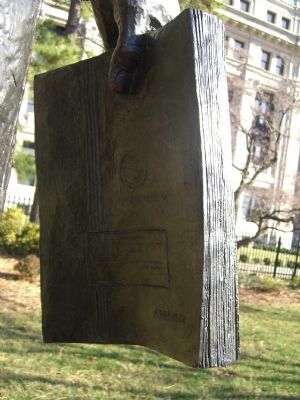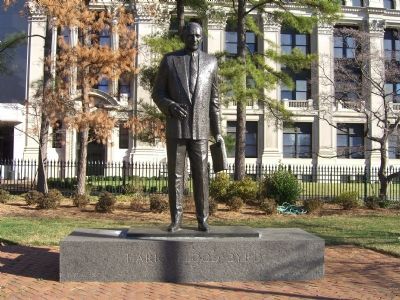Capitol District in Richmond, Virginia — The American South (Mid-Atlantic)
Harry Flood Byrd
State Senator 1916-26
Governor of Virginia 1926-30
United States Senator 1933-65
The General Assembly of Virginia on March 9, 1974, authorized this memorial to Harry Flood Byrd, of Winchester, Virginia, declaring that "The sum total of this one life has had a larger and more lasting effect upon the history and destiny of Virginia and her people than any other in the twentieth century; established personal integrity and fiscal responsibility as first principles of public life and public service; and exemplified the highest traditions established by the outstanding statesment produced by this Commenwealth during its long history.
This statue, financed entirely by private donations, was dedicated June 10, 1976, as a permanent memorial to Senator Byrd and in appreciation of his devotion throughout a long public career to governmental restraint and programs in the best interest of all the people of Virginia.
William M. McVey, Sculptor
Harry Flood Byrd Memorial Commission
Mills E. Godwin, Jr., Governor
John N. Dalton, Lieutenant Governor
John Warren Cooke, Speaker, House of Delegates
E. Blackburn Moore, Leslie Cheek, Jr., Langborne M. Williams
Erected 1976 by Harry Flood Byrd Memorial Commission.
Topics. This historical marker is listed in this topic list: Government & Politics. A significant historical month for this entry is March 1908.
Location. 37° 32.387′ N, 77° 26.048′ W. Marker is in Richmond, Virginia. It is in the Capitol District. Marker is located in Capitol Square. Touch for map. Marker is in this post office area: Richmond VA 23219, United States of America. Touch for directions.
Other nearby markers. At least 8 other markers are within walking distance of this marker. George Washington Monument (within shouting distance of this marker); Inauguration of Davis (within shouting distance of this marker); Zero Milestone (within shouting distance of this marker); Voices from the Garden (within shouting distance of this marker); a different marker also named Voices from the Garden (within shouting distance of this marker); William Smith (within shouting distance of this marker); Edgar Allen Poe (within shouting distance of this marker); Governor Edmund Randolph (about 300 feet away, measured in a direct line). Touch for a list and map of all markers in Richmond.
Also see . . .
1. BYRD, Harry Flood, (1887 - 1966). Biographical Directory of the United States Congress (Submitted on January 13, 2008, by Kevin W. of Stafford, Virginia.)
2. Senator Harry Flood Byrd of Virginia ~ The Pay-As-You-Go Man. Senator Byrd's biography on the Federal Highway Administration website. (Submitted on January 13, 2008, by Kevin W. of Stafford, Virginia.)
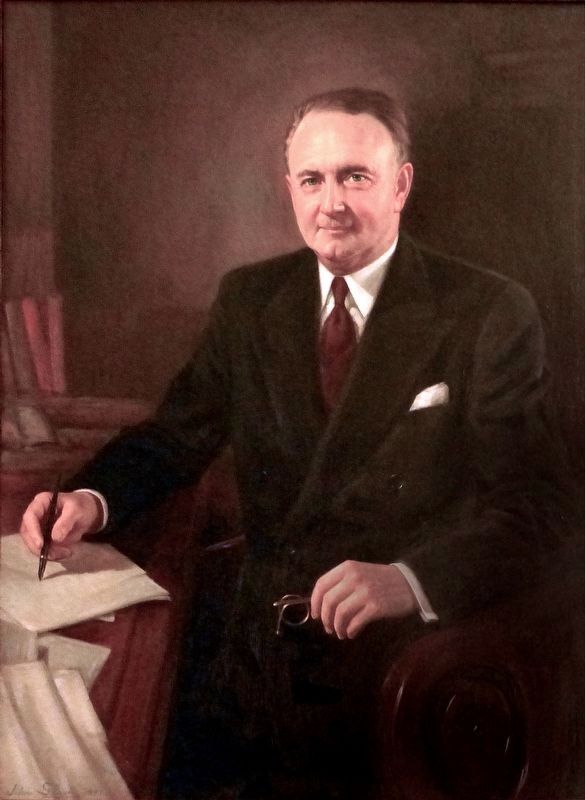
Photographed By Allen C. Browne, December 2, 2015
6. Harry Flood Byrd
This painting of Harry Flood Byrd (1887–1966) by John Slavin hangs in the Virginia Capitol Building in Richmond, Virginia.
“Harry F. Byrd served as a Virginia state senator (1915–1925), governor (1926–1930), and United States senator (1933–1965), was the father of a U.S. senator, and for forty years led the Democratic political machine known as the Byrd Organization. By virtue of both his service and power, he was one of the most prominent Virginians of the twentieth century. But much of that power was wielded in mostly vain opposition to the New Deal's big-government programs and the civil rights legislation of the 1960s. As governor he instituted a popular downsizing of state government that increased efficiency, but the end of his career was marked by his now-infamous ‘massive resistance’ to federally mandated school desegregation.” — Encyclopedia of Virginia
“Harry F. Byrd served as a Virginia state senator (1915–1925), governor (1926–1930), and United States senator (1933–1965), was the father of a U.S. senator, and for forty years led the Democratic political machine known as the Byrd Organization. By virtue of both his service and power, he was one of the most prominent Virginians of the twentieth century. But much of that power was wielded in mostly vain opposition to the New Deal's big-government programs and the civil rights legislation of the 1960s. As governor he instituted a popular downsizing of state government that increased efficiency, but the end of his career was marked by his now-infamous ‘massive resistance’ to federally mandated school desegregation.” — Encyclopedia of Virginia
Credits. This page was last revised on February 1, 2023. It was originally submitted on January 13, 2008, by Kevin W. of Stafford, Virginia. This page has been viewed 1,299 times since then and 29 times this year. Photos: 1, 2, 3, 4, 5. submitted on January 13, 2008, by Kevin W. of Stafford, Virginia. 6. submitted on October 16, 2017, by Allen C. Browne of Silver Spring, Maryland.
